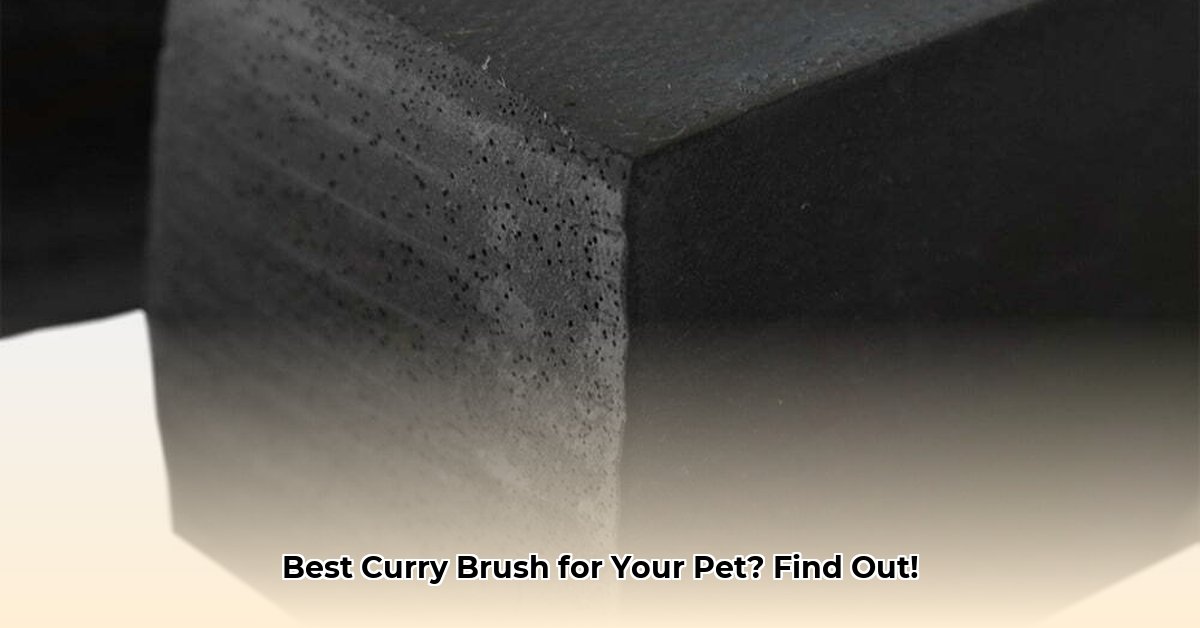Do you want a pet with a happy, healthy, and shiny coat? The right brush makes all the difference! This guide will walk you through selecting and using a rubber curry brush – an excellent grooming tool for many animals. We’ll help you determine the best brush for your furry friend’s coat type, teach proper brushing techniques, and provide tips for keeping your brush clean and in excellent condition. From bristle firmness to handle design, we’ll cover it all, ensuring you make the best choice for your pet’s grooming needs and make the entire process easy and enjoyable. For ultimate pet comfort after grooming, check out these cozy dog beds.
Understanding Rubber Curry Brushes and Their Benefits
Choosing the right grooming tools for your pet can be daunting. A wide variety of brushes are available, and determining which one best suits your pet’s specific needs can be challenging. Let’s simplify the process by exploring the world of rubber curry brushes.
Decoding Your Pet’s Coat: The Foundation of Effective Brush Selection
Before diving into brush types, it’s crucial to understand your pet’s coat. Choosing a brush is similar to choosing clothes – a wool sweater isn’t ideal on a hot summer day. Similarly, a stiff brush on a delicate coat can cause discomfort or injury. Consider these factors when decoding your pet’s coat:
-
Coat Length: Is your pet’s coat short, medium, or long? This is the first and most important factor.
-
Coat Texture: Is the coat smooth, wiry, curly, or silky? Different textures require different bristle types and brushing techniques.
-
Coat Thickness: Is the coat thin, medium, or thick? A thicker coat may require a brush with longer bristles to reach through the fur.
-
Shedding Level: Does your pet shed a lot, a little, or not at all? Pets that shed heavily benefit from more frequent brushing.
Here are some common coat types and suitable rubber curry brush characteristics:
| Coat Type | Recommended Rubber Curry Brush Characteristics | Considerations |
|---|---|---|
| Short, Smooth | Soft to medium firmness bristles, smaller size, possibly rounded edges, flexible rubber | Great for everyday brushing; quick and easy. |
| Short, Thick | Medium firmness bristles, potentially larger size, durable construction | May need more frequent brushing to prevent matting and buildup of dead hair. |
| Medium Length | Medium-soft bristles, slightly longer pins to reach through the coat, flexible brush head | Effective for removing loose hair and distributing natural oils; use with gentle pressure. |
| Long, Thick | Generally not ideal; consider a slicker brush or undercoat rake. If using, opt for a very soft, flexible rubber brush with long, widely spaced pins | Rubber curry brushes might not penetrate the undercoat effectively; use primarily for surface grooming. |
| Wirehaired | Not recommended; these can snag and damage the coat. | Opt for a brush specifically designed for wirehaired breeds, such as a stripping comb or specialized bristle brush. |
This table provides general guidelines. Always observe your pet’s reactions. If they show signs of discomfort, stop and try a different approach or a softer brush.
Beyond Bristles: Selecting the Perfect Brush for Pet Grooming
Bristle firmness is just one aspect. Several other factors influence how well a rubber curry brush works for you and your pet. Here’s how to ensure you’re choosing the perfect brush:
-
Size and Shape: A larger brush covers more area quickly, making it ideal for larger dogs, while smaller brushes are useful for detailed grooming around sensitive areas like the face and paws. Oval brushes often provide a better grip. Experiment to determine what size feels best in your hand and works best for your pet.
-
Handle Design: A comfortable grip is essential! Long grooming sessions can strain your hands and wrists, so an ergonomic handle is a wise investment. Look for handles with a secure feel. Some even have straps for added support.
-
Material Quality: Not all rubber is created equal. Choose a high-quality brush made from durable rubber that won’t warp, crack, or shed bristles after a few uses. A well-made brush is an investment that will last. Look for brushes made from non-toxic, pet-safe materials.
Mastering the Grooming Technique for a Healthy Coat
Grooming should be a positive experience for you and your pet. Follow these steps for a smooth and enjoyable session:
-
Create a Relaxing Environment: Ensure your pet is relaxed and comfortable. A quiet space with minimal distractions is ideal. Rewards are always beneficial.
-
Introduce the Brush Gently: Start with soft, light strokes. Watch your pet’s reactions carefully. If they seem tense or uncomfortable, stop and try again later. Let them sniff the brush and get used to its feel.
-
Use the Correct Brushing Technique: Use short, overlapping strokes, always following the direction of hair growth. Avoid harsh scrubbing motions, which can irritate your pet’s skin. Lift the brush slightly between strokes to avoid pulling.
-
Focus on Problem Areas: Pay extra attention to areas prone to matting, tangles, or dirt buildup, such as the belly, legs, and behind the ears. Be extra gentle in these sensitive areas.
-
Provide Positive Reinforcement: Reward your pet frequently with praise and treats throughout the session. This helps create positive associations with grooming. Talk to them in a soothing voice.
Maintaining Your Brush in Top Condition
Like any tool, your rubber curry brush requires care to last. Follow this guide for keeping your brush in tip-top shape:
-
Clean After Each Use: After each use, remove loose fur and debris. A comb or your fingers can help remove stubborn hair.
-
Wash Regularly: Wash the brush regularly with warm, soapy water. Use a mild shampoo or dish soap. Rinse thoroughly and allow it to air dry completely before storing it to prevent mold and mildew growth.
-
Inspect for Damage: Regularly inspect the brush for cracks, tears, or loose bristles. Replace the brush if it’s damaged to avoid injuring your pet.
Answering Your Questions (FAQs) about Rubber Curry Brushes
-
How often should I brush my pet? This depends on your pet’s coat type and shedding habits. Daily brushing may be necessary for heavy shedders, while weekly brushing may suffice for others. Observe your pet and adjust accordingly.
-
Can a rubber curry brush hurt my pet? When used correctly, no. Always start gently and stop immediately if your pet shows signs of discomfort. Use a light touch and avoid applying too much pressure.
-
What if my pet has sensitive skin? Choose a brush with very soft bristles and use gentle strokes. Monitor your pet’s skin for any signs of irritation. You may also want to consult with your veterinarian about appropriate grooming products for sensitive skin.
-
My brush broke. What now? Invest in a high-quality brush from a reputable brand. Read reviews and look for one made from sturdy materials designed to last. Consider brushes with a warranty.
Regular grooming is crucial for a healthy and happy pet. Choosing the right rubber curry brush and using it correctly creates a positive grooming routine for your furry friend. Enjoy the bonding experience, and remember to adjust your technique based on your pet’s individual needs and preferences.
- Ceramic Kitchen Wall Tiles: Style and Protection for Your Walls - December 17, 2025
- Kitchen tiling wall: Elevate your kitchen with stylish wall tiles - December 16, 2025
- Gray Kitchen Backsplash Tile: Ideas for a Stylish Upgrade - December 14, 2025









